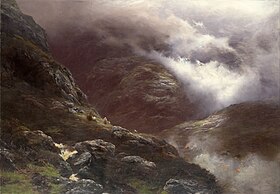| Massacre of Glencoe | |||||
|---|---|---|---|---|---|
| Part of Jacobite rising of 1689 | |||||
 After the Massacre of Glencoe, Peter Graham | |||||
| |||||
| Belligerents | |||||
|
| Clan MacDonald of Glencoe | ||||
| Commanders and leaders | |||||
| Alasdair MacIain | |||||
| Strength | |||||
| 920 | Unknown | ||||
| Casualties and losses | |||||
| None | About 30 killed[1] | ||||
The Massacre of Glencoe[a] took place in Glen Coe in the Highlands of Scotland on 13 February 1692. An estimated 30 members and associates of Clan MacDonald of Glencoe were killed by Scottish government forces, allegedly for failing to pledge allegiance to the new monarchs, William III and Mary II.
By May 1690, the Jacobite rising of 1689 had largely been suppressed, but unrest in the Highlands consumed military resources needed for the Nine Years' War in Flanders. In late 1690, Jacobite clan leaders agreed to swear an oath of loyalty to William and Mary, in return for a payment totalling £12,000. However, disagreements over how it should be shared among the clans meant by December 1691 none had taken the oath.
At this point, Lord Stair, the Scottish Secretary of State decided to make an example of the MacDonalds as a warning of the consequences for further delay. While others, including the Keppoch MacDonalds, also missed the deadline, the Glencoe MacDonalds appear to have been selected due to a combination of clan politics, and a reputation for lawlessness.
While similar events were not unknown in earlier Scottish history, this was no longer the case by 1692, and the brutality of the massacre shocked contemporaries. It became a significant element in the persistence of Jacobitism in the Highlands during the first half of the 18th century, and remains a powerful symbol to this day.
Cite error: There are <ref group=lower-alpha> tags or {{efn}} templates on this page, but the references will not show without a {{reflist|group=lower-alpha}} template or {{notelist}} template (see the help page).